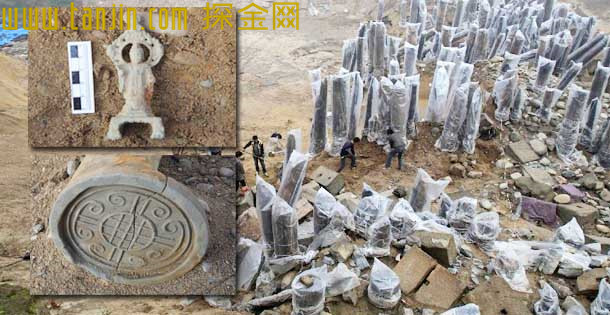
Xinhuanet Xi'an On January 19th, after three years of continuous archaeological work, it was located on the north side of Xi’an Hanchang’an City site in Xi’an and spanned the Weihe River’s “Silk Road First Bridgeâ€â€”Jiaoqiao site, and obtained the north end of the giant bridge. New discoveries such as boats, Buddha statues, coins, and stone carvings from the Han Dynasty provided important data for showing the majestic posture of ancient bridges, reconstructing the network structure of the ancient capital of Chang’an, and restoring the cultural history of ancient bridge art.
Since the Songqiao site was discovered in April 2012, the Jianqiao archaeological team, which consists of the Institute of Archaeology at the Chinese Academy of Social Sciences and the Shaanxi Provincial Institute of Archaeology, has successively rescued the kitchen gate group and the Luocheng gate bridge at Han Chang'an City. Sex excavation, related discoveries were selected as “2013 Top Ten Archaeological Discoveries of the National Archaeologyâ€, and No. 1 kitchen gate was even praised by the huge number of friends for the “Silk Road First Bridgeâ€, which has attracted continuous attention in the society and academia at home and abroad.
Liu Rui, an associate researcher at the Institute of Archaeology at the Chinese Academy of Social Sciences who chaired the 2014 archaeological excavations, said that the archaeological work of the Yongqiao site will be carried out through archeological explorations, excavations, and surveys to understand the distribution of the ancient bridge from Xianyang to Xi’an during different periods. The traffic network around Chang'an City in different periods has restored the trend of the Weihe River in this area since the Qin and Han dynasties. Through the study of the history of the change of the Weihe River in Xi'an, it provides information for the study of environmental changes in Guanzhong.
Because the Xi'an high-speed rail car use infrastructure site happens to be in the "silk road first bridge" - the north end of kitchen gate 1 bridge, the archeological team accidentally discovered the remains of the ancient bridge in the construction unit, then began rescue excavation. As a result, within the excavation area of ​​about 2,000 square meters, 97 rows of 97 piles of bridge piles were initially cleared. The diameter of a single wood column was 0.12-0.48 meters. As a result, the northern end of No. 1 kitchen gate has been basically determined.
Liu Rui said that on the southeastern edge of the ancient bridge, a hydraulic facility “埽†woven with bamboo and filled with tile, stone, sand, etc. was found to determine the location of the “Hesong†on the north bank of the river at that time. At the same time, in the pebble accumulation in the eastern part of the bridge, the local components of the ancient ship are also exposed. If they can be fully excavated, it will undoubtedly fill the gap in the archaeological excavation of the Luohe River in Chang’an.
In addition to the rescue excavations, archaeologists focused on the anatomical cleanup of the southern part of the No. 1 kitchen gate of the Kitchen Gate in 2012-2013. In the seventh and eighth layer of sand after the abandoned No. 1 bridge, there was copper, Pottery, iron, silver, porcelain utensils of various textures. Among them, mainly copper coins account for more than 900 pieces, with "half two", "five magpies", "Kaiyuan Tongbao", "Yuanquan", and "Great Spring 50", and there are also coins of different periods in the Song, Ming and Ming dynasties.
Experts believe that many of the “Qianlong Tongbao†and 1 “Jing Xing Tong Bao†copper coins were unearthed, reaffirming that the upper limit of the time in this layer does not exceed the Qing Dynasty. Excitingly, at the dissection of two large rectangles of the Han Dynasty stone carvings, the shallow bas-reliefs of Suzaku and Qinglong, Suzaku and Baihu were found. Although water-washing is still obvious, the pattern should be on the stone carvings of the Han Dynasty in the ancient Chang’an area. The first discovery.
Li Fangfang, a researcher at the Institute of Archaeology at the Chinese Academy of Social Sciences, said that in 2014, archaeologists also carried out archeological explorations in some regions and carried out archaeological surveys of key areas, further confirming that there is a No. 1 kitchen gate on the north side of the Han Chang'an City site. With the bridge as the center, within the range of 400 meters from east to west, there are at least five large ancient bridges of the Weihe River. Such an ancient bridge with high density can be described for the first time in archeology. It has a history of studying the changes of the Weihe River in Xi’an and the history of the Guanzhong environment. Important value.
The turn-out scrap Metal Baler machine is used to compress scrap metal (steel, copper, aluminum, stainless steel, etc)into metal block or metal bale. The purpose is to save the transportation cost or reduce the raw material loss when smelting.
After compressing, the metal bale is easy to transport and store, so it can save transporation cost, reduce storage area and reduce the loss when smelting. Easy operation, durable and long service life, high efficiency, etc.
1) Hydraulic drive, compact design, great sealing;
2) Customized press box size and bale size;
3) Bale discharging ways include turn-out, side-push out and forward-out;
4) Designed with quick unit that can improve work efficiency substantially;
5) Famous motor, hydraulic system, oil cylinder, piston pump, electrical components;
6) Blades: our scrap metal baler machine with the knife, it can cut the long size material when compressing, so it very goog for the long steel wire and big size material.
Turn-out Baler, Turn-out Baling Machine, Turn-out Baling Press, Turn-out Baler Equipment, Turn-out Metal Compactor
Jiangyin Metallurgy Hydraulic Machinery Factory , https://www.eco-metalsrecycle.com
![<?echo $_SERVER['SERVER_NAME'];?>](/template/twentyseventeen/skin/images/header.jpg)